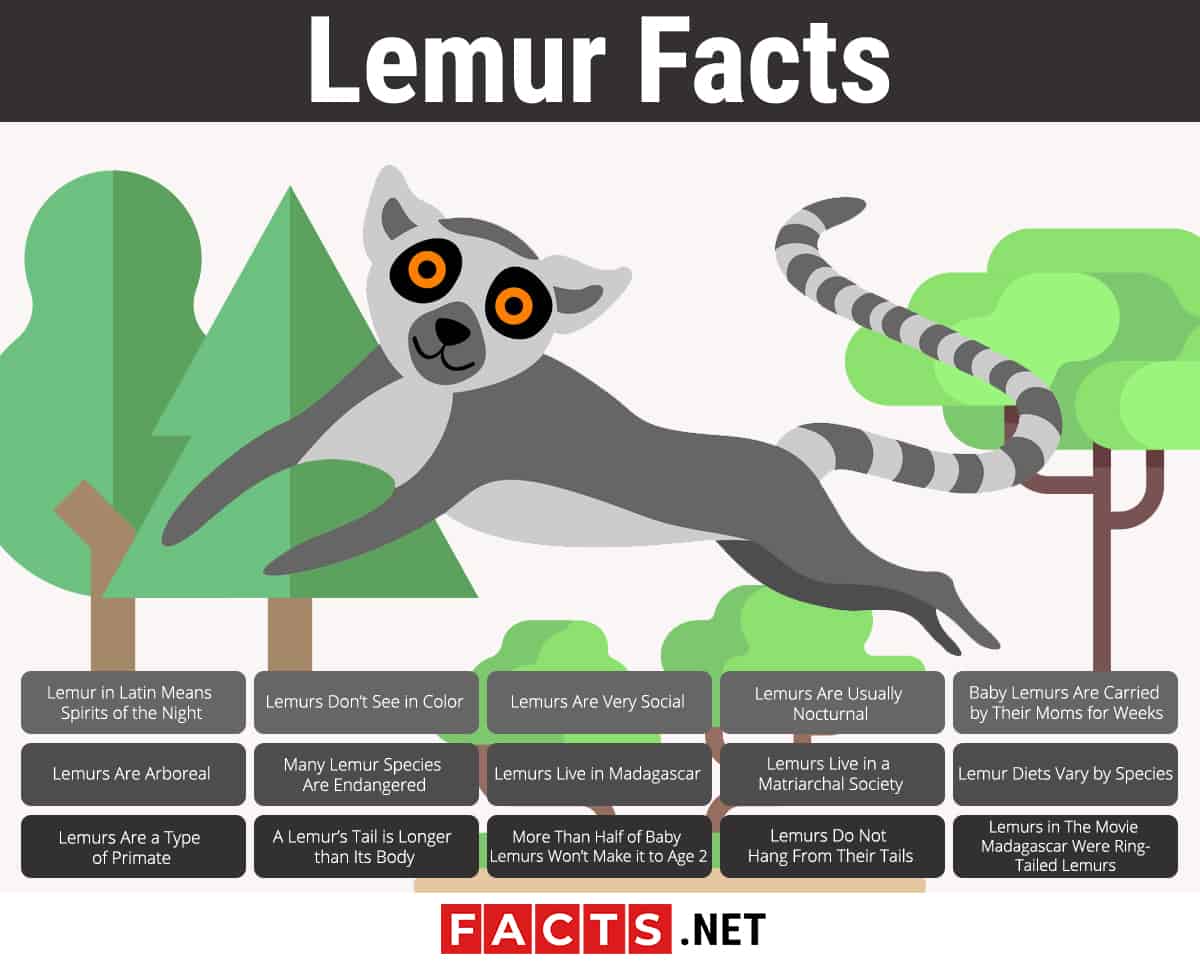
- Scientific Name: Lemuroidea
- Classification: Mammalia
- Family: Lemuridae
- Habitat: Tropical rain forest
- Species: At least 99
- Weight: Varies by type; 1 ounce to 15 pounds
- Size: Varies by type; 3-39 inches
- Speed: 12 miles per hour
- Lifespan: 15 years
- Types: Ring tailed lemur, red ruffed lemur, indri lemur
- Origin: Lemur in Latin Means Spirits of the Night
- Senses: Lemurs Don’t See in Color
- Behavior: Lemurs Are Very Social
- Behavior: Lemurs Are Usually Nocturnal
- Reproduction: Baby Lemurs Are Carried by Their Moms for Weeks
- Behavior: Lemurs Are Arboreal
- Conservation: Many Lemur Species Are Endangered
- Location: Lemurs Live in Madagascar
- Behavior: Lemurs Live in a Matriarchal Society
- Diet: Lemur Diets Vary by Species
- Lemurs Are a Type of Primate
- A Lemur’s Tail is Longer than Its Body
- More Than Half of Baby Lemurs Won’t Make it to Age 2
- Lemurs Do Not Hang From Their Tails
- Lemurs in The Movie Madagascar Were Ring-Tailed Lemurs
Lemur Facts Infographics

Lemur in Latin Means Spirits of the Night
Lemur facts show that lemurs were feared by the natives of Madagascar. Their appearance can be unnerving, especially during the night when they are most active. The natives’ experiences led to the animal being given the name we now all know. There are many legends that involve lemurs.
Lemurs Don’t See in Color
Lemur facts tell us that most lemurs only see in one or two colors. In some species, the females may be able to see in three. Regardless of how many colors they can see in, a lemur’s night vision is better than its vision during the daytime hours. This is why many of these animals prefer to hunt at night.
Lemurs Are Very Social

Lemurs prefer to live in families. These families usually contain about 15 members and consist of males, females and their offspring. Females will typically stay with the same group for their whole life. Occasionally a family will only consist of females and offspring if the males have been driven out. The male may be forced to live alone or to join a group of only male lemurs. Lemur families bond with each other through social grooming.
Lemurs Are Usually Nocturnal
Lemur facts show that many types of lemurs are nocturnal so they spend their days sleeping and their nights being active and foraging for food. There are some species though that is the opposite. Their habits depend on whether it is safer during the day or night for that specific type of lemur.
Baby Lemurs Are Carried by Their Moms for Weeks
When a baby lemur is first born, it will cling to its mother’s stomach for two weeks. After this time, the baby will ride on its mother’s back until it is ready to go out on its own. Most lemurs only give birth to one baby at a time, but twins are not unheard of. Until it is able to eat solid food, a baby lemur will drink its mother’s milk.
Lemurs Are Arboreal
Most lemurs are arboreal, which means that they spend most of their time living in trees. They look for food in the branches and swing from tree to tree. They will occasionally come down to the ground to search for nuts or berries but typically remain above ground. The main exception to this rule is the well-known ring-tailed lemur, which spends the majority of its day on the ground.
Many Lemur Species Are Endangered

Lemur facts show that a lemur’s only two natural predators are the fossa and the harrier hawk. However, most species are endangered because of hunting by humans. Lemurs’ natural habitats have also been greatly decreased due to the clearing out of trees in certain areas. With their young having a high mortality rate, it is difficult to increase a species’ population.
Lemurs Live in Madagascar

Lemurs are only found naturally on the island of Madagascar, located off the southeast coast of Africa. They can be found throughout the world now in zoos, but are often not seen much by the public due to their tendencies to remain hidden during the day.
Lemurs Live in a Matriarchal Society
Only a few species of animals display a matriarchal society, and Lemurs are one of them. In this society, the females have more control over the males and tend to be in charge of each family group. They control the food and activities for the day and have the right to evict a male from the group.
Lemur Diets Vary by Species
Every species is a little different but most lemurs’ diets consist of fruits and nuts. They will also consume certain insects. If it is a time of year where there is not much food available, lemurs will hibernate. The lemur is the only primate that will slow down its metabolism to survive a shortage of food.
Lemurs Are a Type of Primate
Lemurs are considered to be medium-sized primates or apes. They share many similar characteristics with other primates. They are currently considered to be the most endangered primate.
A Lemur’s Tail is Longer than Its Body

A lemur’s tail is often longer than the full length of its body. When walking, the lemur will hold and arch its tail high above its head. This gives the lemur more balance when walking or running. The tail is also important when moving about high in the trees and is used as a form of communication between lemurs.
More Than Half of Baby Lemurs Won’t Make it to Age 2
Baby lemurs more often than not do not make it to adulthood. They are easy targets for hawks and other predators. They also may have trouble finding food or may become separated from their group, which makes them more vulnerable.
Lemurs Do Not Hang From Their Tails
Most primates have prehensile tails or tails that allow them to hang freely and easily from tree limbs or similar structures. Lemurs do not have this capability, although it is often portrayed through cartoons that they do. A lemur’s tail is mostly for balance and communication.
Lemurs in The Movie Madagascar Were Ring-Tailed Lemurs

Several characters in the widely popular movie Madagascar and sequels were lemurs. The specific type of lemurs portrayed were ring-tailed lemurs. Their features and characteristics were portrayed quite accurately!
Lemur Facts – Facts about Lemurs Summary
 Lemur facts cover a wide range of topics. The animal’s name has an interesting history, and the lemur’s behavior patterns are different from most primates. They are incredibly social animals but most species are endangered, mainly due to the hunting practices of humans. They are represented in pop culture and are a popular animal.
Lemur facts cover a wide range of topics. The animal’s name has an interesting history, and the lemur’s behavior patterns are different from most primates. They are incredibly social animals but most species are endangered, mainly due to the hunting practices of humans. They are represented in pop culture and are a popular animal.
Was this page helpful?
Our commitment to delivering trustworthy and engaging content is at the heart of what we do. Each fact on our site is contributed by real users like you, bringing a wealth of diverse insights and information. To ensure the highest standards of accuracy and reliability, our dedicated editors meticulously review each submission. This process guarantees that the facts we share are not only fascinating but also credible. Trust in our commitment to quality and authenticity as you explore and learn with us.


